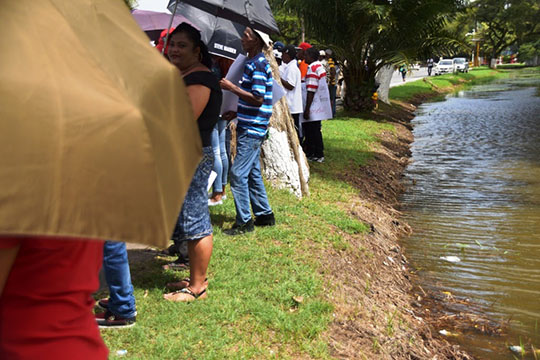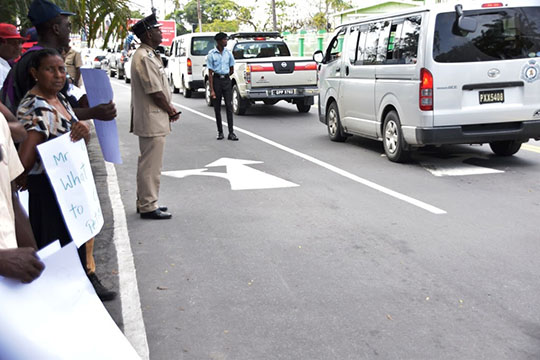Region Four A Commander Assistant Commissioner Edgar Thomas has refuted a claim by the Guyana Agricultural and General Workers’ Union (GAWU) that the police force abused its power to suppress sugar workers who were exercising their freedom of expression during a protest one week ago.
Thomas insists that the police were just maintaining order.
The union, in a press statement issued last Wednesday, voiced its concern that the security apparatus of the state is being used to suppress the citizens’ freedom of expression.

Over 3,000 sugar workers across the country began striking last week for higher wages and a protest was also staged in front of the Ministry of the Presidency on Vlissengen Road, in Georgetown.
Workers have not been given any increases over the past five years as a result of what they contend is clear discrimination.
In a statement issued last week, GAWU said that during the picketing exercise several restrictions were imposed by the Guyana Police Force.
“Members of the Guyana Police Force imposed several restrictions, which in our view, were aimed mainly at stilling the workers slogans and cries,” it said.
The statement noted that at the commencement of the exercise, protestors assembled on the western side of Vlissengen Road, directly in front of the president’s office.
For many years, the union added, protestors were allowed to gather there and to express their views without being intimidated or being asked to remove.
However, it noted that within minutes of its protestors’ actions, a police vehicle arrived on the scene and several officers required them to remove from the parapet in front of the president’s office.
“The officers shared that it was a security precaution though we posed no threat to life, limb or property and were peacefully demonstrating. We had to wonder whether the Force responds to calls from citizens with such swiftness,” the statement said.
As a result, GAWU said the protesters were then “forced” onto the eastern side of Vlissengen Road.
“Our assembly there came with several restrictions. The officers demanded that we remain behind the eastern-most lane marker. As a result the protestors were confined to the rain-soaked, muddied, narrow parapet in front of the trench that runs parallel to the Castellani House,” it noted.
It further said that the restriction was imposed although it was “possible” for the police to restrict traffic on one of the two lanes of the eastern carriageway of Vlissengen Road.
“In fact, we heard one officer suggesting this to the senior rank on the scene but this suggestion was obviously ignored. What was interesting is that a junior rank was placed in the carriageway to prevent traffic from utilising some sections of the lane but the picketers were told to remain in the muddied area. Apart from that, a contingent of policemen and women took up strategic positions. At one time, a police bus brought several policemen to the scene. Later a truck carrying several metal barricades arrived, seemingly, with the intent to place further restriction,” the statement added.
However, when contacted, Thomas told Stabroek News that no restrictions were set by the Guyana Police Force during the picketing exercise.
He pointed out that the protesters were the first to arrive at the location.
“They (protestors) took ground before the police. We could have only set restrictions if we had first arrived,” he said.
He maintained that the police were merely performing their duties to maintain order on the roadway during the protest.
“The officers on the scene indicated that their actions were intended to maintain the flow of traffic, a situation, as we pointed out, [that] could have been addressed without much disruption… We must say we take the officers’ explanation with a pinch of salt. Certainly if the police is so concerned about traffic, then the large blockades we see being erected whenever the president is present at venues would have not been erected in the first place. Those blockages, we remind, sometimes extend into several streets and apart from a major inconvenience, are severely disruptive,” the statement noted.
The statement also accused a police officer of grabbing a worker by his shirt and threatening to arrest him if he stepped beyond the lane marker.
Thomas admitted to Stabroek News that he was the officer. He said that he did indeed grab the protestor and threatened to arrest him if he did not abide by the rules. He said upon being given a second chance, the protestor adhered.
GAWU said it believes that the restrictions were intended to minimise the visibility of the protest. “Obviously, the protest must have been seen as an embarrassment to some and must have gotten under the not-so-thick skin of some in power,” it noted.










